Castle in Fall Colors
November 13th, 2011
On Saturday, Lynne and I took the NEH representatives north into Turkish occupied Cyprus. We went first to St. Hilarion’s castle, which seems to grow out of the rock at the top of a prominent hill overlooking the Mediterranean Sea. From a distance, if you don’t look closely, the remains of the castle blend in with the rock; and it just looks the a rocky outcrop.
The weather was cool and the wind chilly, but the bonus was the color in the leaves. Now that the temperature has dropped, fall colors are obvious at higher elevations. In Nicosia, the color changes are far more subtle. We need a light jacket in the morning and evening. During the day the sun typically shines and short sleeve shirts are enough. Yesterday on the mountain, however, we were wearing sweaters.
Although the sun rarely emerged from behind the clouds, the sky did make for some interesting effects with HDR photography.
Going to the mountain for a second time had the advantage of knowing more what to expect and think ahead about composing photographs.
Some of the large windows in the ruins provide nice vistas of the land and sea below. Gazing down, one can hardly help but to imagine what the castle was like back in Crusader times when this fortress provided a fortified defense against invaders. The Venetian castle at the Kyrenia harbor is clearly visible from St. Hilarion.
We ate lunch inside a cafe in Kyrenia, because the blustery wind on the coast was chilly, and sitting at a table outside would have been unpleasant. After lunch, we explored the Kyrenia castle. Inside one of the large display rooms is a Greek merchant vessel that sank just north of Kyrenia in the fourth-century B.C. Divers found the wreck when they noticed hundreds of amphora on the sea bottom. Some were still sealed, so archaeologists could retrieve the almonds and other goods stored in these pottery jars. Spear points embedded in the hull, as well as several tons of missing cargo, indicate that the ship may well have been sunk as a result of piracy.
The wood from the ship long ago collapsed under the weight of the amphora, but divers recovered a good bit of the wood. Experts had to soak the wooden pieces for years in fresh water, then distilled water in an effort to remove the salt that had impregnated the wood. Then they immersed the wood in a kind of wax solution for a decade (I think) to restore enough structural integrity that the archaeologists could go about the tedious process of reassembling the vessel–a process that took years.
I learned that the outer planks were sewn onto the ribs of the boat with rope, and then pitch was applied to seal the holes. Archaeologists found in the middle of the boat 29 rectangular grinding stones that were used as ballast. Part of the cargo, these mill stones would be sold at another port of call.
From Kyrenia, we took our NEH friends to Bellapais Abbey, and then we headed back to Nicosia so that they would not be late for their flight. Of course, we had difficulty finding the road that leads to the checkpoint; so we lost time driving around the old city. But we stopped to ask for directions and finally got on the right road. Our guests were tired but happy. They saw some amazing archaeological sites.
Posted in Uncategorized | 3 Comments »


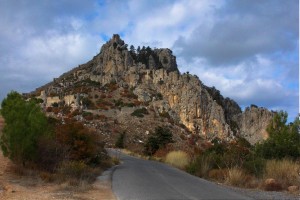
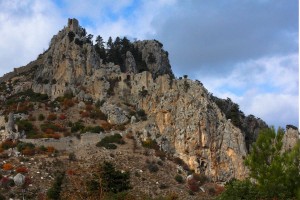
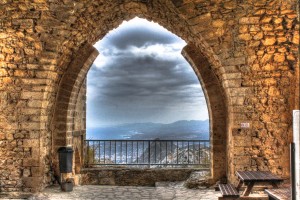
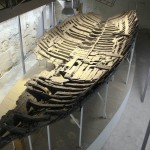
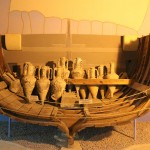
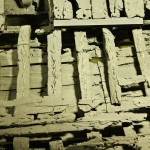
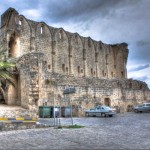
November 16th, 2011 at 9:21 pm
I love the picture of St. Hilarion’s Castle. The rest I can’t say, since we missed these spots. We surely crowded a lot into our week, but obviously we missed a lot as well!
So thankful you are better!
November 20th, 2011 at 10:44 am
Sorry I have to correct the first few lines of this treatise. the North is not “occupied”; Turkey intervened when the greeks under Macarios where trying a genocide on the turkish population to enforce “ENOSIS” – the union of the whole Island with Greece
November 20th, 2011 at 2:29 pm
What I have noticed during my time in Cyprus is a refusal to acknowledge wrong doing by one’s own group, plus a developed rhetoric of condemnation of the other side. Greek Cypriots speak at length about the Turkish invasion of the northern part of Cyprus, and they continually recount the brutal expulsion of Greek families from their homes by the Turkish forces. The date 1974, which I notice is part of your email address, lives in infamy among the Greek Cypriots. And their complaints are valid. What they do not say is anything about the brutal treatment of Turkish Cypriots by Greek nationalists who pushed for Enosis and wanted to rid the island of the Turks. I never hear them speak about 1963 or 1967, dark dates that occupy the minds of the Turkish Cypriots. The rhetoric is all about Turkish atrocities, which, in fact, happened. What I do not hear is any admission that Greek brutality had anything to do with the Turkish invasion.
Turkish Cypriots, on the other hand, speak of 1974 as the year of liberation—as the year of the Turkish peace operation (not invasion). They have their own stories of atrocities committed by Greeks against them—about Turkish Cypriots being killed and forced to live in enclaves, and finally having to leave their homes in the south. The atrocities happened. What I do not hear from the Turkish Cypriots is anything about the suffering inflicted on the Greeks in the north—or the massive desecration of churches and monasteries. It is all the fault of the other side.
The selective memory of both Turkish and Greek Cypriots regarding the history of the island does not, in my opinion, provide much room for solving the Cyprus problem. Until each side matures enough to be able to come to grips with its own wrongdoing, little hope for an end to the conflict exists. Historians have to be brave enough to tell the truth about both sides and teach children the whole story—not just the propaganda that fits the agenda of each side.
I recommend that you read a balanced account that gives voice to both sides: Echoes from the Dead Zone: Across the Cyprus Divide by Yiannis Papadakis (London: I.B. Tauris, 2005). Papadakis, as part of his graduate studies, lived in Greece, Istanbul, Lefkosia, Lefkosha, etc. He listened carefully to the stories of average Greeks and Turks and honestly reports both sides. It is the most helpful book I have read about Cyprus. As a Greek, he was brave to publish the book, because many Greek Cypiots consider him to be a traitor for telling unflattering stories about the Greek Cypriots